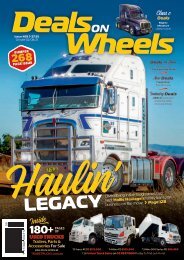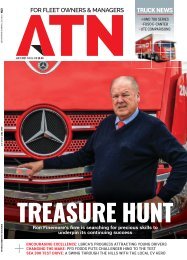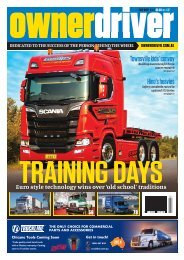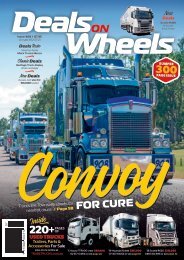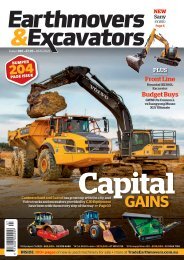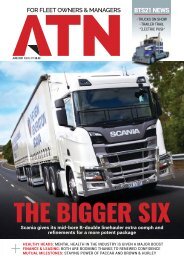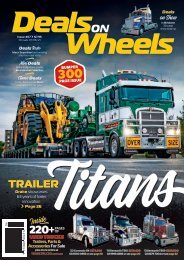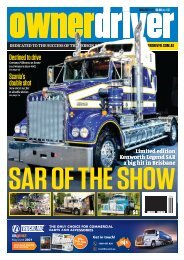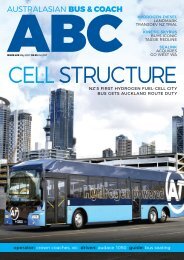Owner/Driver #339
You also want an ePaper? Increase the reach of your titles
YUMPU automatically turns print PDFs into web optimized ePapers that Google loves.
INDUSTRY COMMENT Andrew Harbison<br />
Around the curve<br />
Transport planning in the COVID recovery phase<br />
JUST 12 MONTHS AGO, I was penning<br />
a speech for an industry event<br />
and the theme was ‘Preparing<br />
for Change’. All signs pointed to<br />
Australia’s road transport industry<br />
as poised at the edge of sweeping<br />
change – in terms of technological<br />
advancement, customer preference and<br />
product appeal.<br />
As the name of the theme suggests, one of<br />
the focus points was the concept of preparing<br />
our businesses to pivot with change.<br />
I still believe the most successful to emerge<br />
on the other side of this ‘evolution’ will be<br />
those planning for, and adapting quickly to,<br />
unfolding challenges.<br />
It was truly a significant year for road<br />
transport in Australia last year.<br />
From bushfires to COVID-19, to supply<br />
chain chaos and a national truck law review,<br />
not to mention intrastate border restrictions<br />
that continued to change week on week.<br />
Planning and processes that help guide<br />
and inform our response to situations such<br />
as we’ve seen over the past year are critical for<br />
a functioning industry, and in supporting the<br />
country post-COVID.<br />
I place particular emphasis here on<br />
having a structured, robust and, importantly,<br />
practiced approach to critical incidents.<br />
This ‘business readiness’ will give operators<br />
a strong head start when issues arise,<br />
whatever they may be.<br />
At the time of writing this article, my<br />
hometown of Melbourne has recently<br />
emerged from a five-day ‘snap’ lockdown in<br />
another attempt to quash virus outbreaks.<br />
Western Australia is also coming out of a<br />
similar lock-down period.<br />
Let us take some spirit in the fact that we<br />
are now well-versed and prepared to tackle<br />
these disruptions head-on. It is one more<br />
bump, and assuredly not the last, on the road<br />
to national recovery.<br />
ENCOURAGING SIGNS<br />
News of a vaccine rollout is imminent and a<br />
stronger than expected economic recovery<br />
predicted for 2021.<br />
According to Deloitte’s Access Economics<br />
report, conditions post vaccine will look very<br />
different to those now – with a 3.1 per cent<br />
hike in business investment and a 6 per cent<br />
increase in household spending predicted<br />
in 2021, while Australia’s overall economic<br />
output is expected to jump 4.4 per cent.<br />
This is supported by Westpac’s rolling<br />
Consumer Sentiment Index, which shows<br />
confidence at a 10-year high in October 2020:<br />
this is 48 per cent above the lowest levels<br />
reached during our toughest lockdown<br />
period in April 2020.<br />
Our behaviour as consumers serves to<br />
highlight the difference between this COVID<br />
recession and others in the past, including<br />
the downturn during the Global Financial<br />
Crisis and the grinding recession of the 1990s.<br />
Evidence of this confidence and other<br />
positive indicators (including the job<br />
market’s steady improvement with six out<br />
of seven initial job losses caused by the<br />
pandemic reclaimed), should provide further<br />
hope that the longer-lasting downsides seen<br />
in recessions of the past, will be contained.<br />
It is vital that businesses and households<br />
fortunate enough to have established a buffer<br />
over the past year, while taking advantage of<br />
various incentives and tax breaks, will use<br />
that buffer to help offset the impact on the<br />
economy with the withdrawal of support<br />
programs.<br />
Indeed, Isuzu’s own research into the road<br />
transport industry shows businesses are<br />
prepared to ‘spend to stimulate,’ with 50 per<br />
cent of operators willing to purchase new<br />
equipment with the help of government<br />
incentives, which bodes well for the<br />
recovering economy.<br />
SOLID FOUNDATIONS<br />
Share markets worldwide have broadly<br />
reflected business and consumer confidence,<br />
with gains almost wiping out the huge losses<br />
experienced at the outset of COVID.<br />
However, the volatility of these markets<br />
and the chain effects of international trade<br />
‘obstacles’ – for want of a better word – must<br />
be recognised, particularly here in Australia.<br />
Given our delicate situation with China at<br />
the moment, this is a work in progress.<br />
On this point, I think it is important to<br />
note that Australia is increasingly standing<br />
on its own two feet.<br />
ANDREW HARBISON<br />
is director and chief<br />
operating officer of Isuzu<br />
Australia Limited (IAL)<br />
According to Deloitte economist, Chris<br />
Richardson, our national income has so<br />
far increased rather than been adversely<br />
impacted by current trade circumstances.<br />
In reference to the effect of trade tensions<br />
on the road transport sector and other<br />
industries fundamental to the national<br />
economy, I believe, in essence, that we<br />
are fully prepared to grow and find new<br />
opportunities and markets.<br />
TRANSPORT ADAPTABILITY<br />
Businesses in road transport now have<br />
a better understanding of the idea that<br />
we must adapt processes and plans for<br />
uncertainty in international parts supply,<br />
and be well prepared to meet these sorts of<br />
challenges before they arise.<br />
And in many ways, Australia’s road<br />
transport operators are old hands at evolving.<br />
In a diverse and competitive industry,<br />
operators are quick to adopt technology,<br />
build cooperative relationships and have<br />
comprehensive strategies in place to<br />
changing address market demands.<br />
As for demand in Isuzu’s own market of<br />
truck and power solutions manufacturing<br />
and sales – the federal and state budget<br />
stimulus has created somewhat of a ‘perfect<br />
storm’ of conditions this year.<br />
Average growth of two and a half per cent<br />
each year is forecast for the freight and<br />
logistics sector through to 2024. Construction<br />
and related industries are also booming.<br />
All economic indicators are pointing to a<br />
strong year ahead, with a few headwinds to<br />
be mindful of and a concerted push to take<br />
up new technology.<br />
As always, we should be looking for growth<br />
as usual, not business as usual.<br />
We know it will be strong industry<br />
relationships and innovative thinking, along<br />
with rock-solid planning and processes, that<br />
will drive us into the future.<br />
This in the hope that ‘change’, in whatever<br />
form it may take, is ours to embrace and<br />
harness.<br />
“We should be looking<br />
for growth as usual, not<br />
business as usual.”<br />
54 APRIL 2021 ownerdriver.com.au




